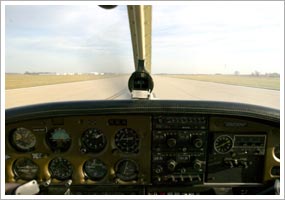| This ePilot Flight Training Edition is sponsored by

Advertisers
                  
Do not reply to this e-mail. Got news? Contact ePilot. Having difficulty using this service? Visit the ePilot Frequently Asked Questions now at AOPA Online or write to [email protected].
Aircraft Owners and Pilots Association
421 Aviation Way
Frederick, MD 21701
Tel: 800/USA-AOPA or
301/695-2000
Copyright © 2007 AOPA. | | Training Tips | | A CLASS DEPARTURE
Recent Training Tips focused on arrival procedures at nontowered airports, but that's only half the story. You also need to know the proper way to depart nontowered airports. Leaving the area means following the safest way out and adhering to recommended departure  procedures as well as any specific local guidelines that may be in effect because of terrain, obstructions, or noise abatement programs. See the Nov. 29, 2002, Training Tips article, "No noise is good noise," for information on noise abatement. procedures as well as any specific local guidelines that may be in effect because of terrain, obstructions, or noise abatement programs. See the Nov. 29, 2002, Training Tips article, "No noise is good noise," for information on noise abatement. While preparing to depart, you should be monitoring the common traffic advisory frequency (CTAF) and scanning the pattern for conflicting traffic. You also need to have a plan before you taxi onto the runway and commence the takeoff roll. Don't improvise the departure; safety depends on avoiding unexpected maneuvering. "If departing the traffic pattern, continue straight out or exit with a 45-degree turn (to the left when in a left-hand traffic pattern; to the right when in a right-hand traffic pattern) beyond the departure end of the runway, after reaching pattern altitude," advises Chapter 4 of the Aeronautical Information Manual. To make a safe departure, you need to know how other aircraft might be arriving in the area. "Depending on your intended route, you can take your leave of most airports without crossing part of a potential arrival path. It just takes a little planning and sound knowledge of the airport traffic pattern and common arrival corridors," Julie K. Boatman wrote in the December 2005 AOPA Pilot feature, "Up and Out"-an article written partly in response to suggestions from a pilot who wrote: "The most egregious things I see every day are departing pilots flying through the standard arrival route after takeoff!" (See the article's "Three to go" tips for a smooth departure.) When is it proper to switch from the CTAF on departure? AOPA's Handbook for Pilots counsels, "Monitor the appropriate frequency and establish and maintain communications from start, during taxiing, and until 10 miles from the airport, except when federal aviation regulations or local procedures require otherwise." Like a safe traffic-pattern entry, a good departure is a well-planned piece of flying.
| | Your Partner in Training | | Displaced threshold. Empennage. MEL. Pirep. What does it all mean? Aviation is an industry of acronyms and technical language. AOPA's Student Glossary for General Aviation can help you make sense of it all. Log on to AOPA Flight Training Online for a glossary of terms, a phonetic alphabet chart, and a new pilot's guide to air traffic control communications. Do you have a question? Call the experienced pilots in AOPA's Pilot Information Center at 800/USA-AOPA. They're available to take your calls weekdays 8:30 a.m. to 6 p.m. Eastern. As an AOPA Flight Training Member, you have access to all of the features within AOPA Online and AOPA Flight Training Online. Login information is available online.
| | Flight Training News | | AIR SAFETY FOUNDATION RELEASES 2007 'NALL REPORT'
The AOPA Air Safety Foundation released the 2007 Joseph T. Nall Report this week, providing an overview of GA accident statistics from 2006, including trends and contributing factors. The report finds that the general aviation fixed-wing safety record continued its improvement in 2006, reaching historic lows for both total (1,319, down 8.3 percent from 2005) and fatal accidents (273, down 6.5 percent). Instructional flying is relatively safe, accounting for 20.1 percent of total GA flight time but only 13.1 percent of all accidents and 7.7 percent of fatal accidents. This is due, in part, to the high level of supervision and structure in the training environment. Also of note: Maneuvering flight, a consistent leader in fatalities, dipped significantly from 80 (33.1 percent) fatal accidents in 2005 to 54 (25.0 percent) in 2006. Visit AOPA Online to download the entire report. STUDENT GETS PRIVATE PILOT CERTIFICATE IN NINE DAYS
Fresh from a tour in Iraq, a U.S. Army captain completed a private pilot course at a Florida flight school and took the checkride-all in nine days. Capt. Matthew Shifrin trained with Tailwheels Etc. at Winter Haven's Gilbert Airport. Shifrin, of the 16th Military Police Brigade (Airborne), researched flight schools while stationed in Iraq and settled on Florida because of its good weather. His instructor and his examiner said Shifrin's military discipline was evident in his approach to flight training, according to an article on the Polk Online Web site. HARVARD SEES RESURGENCE OF AVIATION CLUB
Harvard University's Aviation Club recently received official student group status, and organizers celebrated Dec. 10 by hosting an event that provided helicopter rides for students. Planning for the event began in October, according to a report in The Harvard Crimson. The club had to scout a field near the university without physical obstructions, obtain permission to use the space, and get approval from the university police department. Students paid $20 each to take a short ride around downtown Boston. Proceeds went to establishing a library for Harvard students who are studying for a pilot certificate. The aviation club has existed in some form or another since the 1920s.
| | Inside AOPA | | AIR SAFETY EXPERT TO INSPIRE YOUTH IN AVIATION
Introducing high school students to the wonder and challenges of aviation is vital to boosting the dwindling pilot population. Now, in addition to helping pilots fly safely, AOPA Air Safety Foundation Executive Director Bruce Landsberg has the opportunity to help inspire youth to pursue aviation-related careers and hobbies. Landsberg was appointed to the Build A Plane advisory board on Dec. 5. Build A Plane has a formal partnership with the FAA to promote aviation education by soliciting donated aircraft to distribute to high schools, giving students the opportunity to build or restore an aircraft. Read more on AOPA Online. IT'S A WRAP! CELEBRATING THE SWEEPS CARDINAL
We're finishing up work on the 1977 Cessna Cardinal we've completely refurbished for AOPA's 2007 Sweepstakes. To celebrate all the hard work that's gone into the project, we threw a party for the team in Griffin, Ga., who gave their utmost during the past year to make it happen. You can see the Catch-A-Cardinal's final statistics, including its new empty weight, cruise speed, and climb rates, along with pictures from the holiday party in this week's update. This will be the last update on the Cardinal until it's given away, but we'll have a new airplane for you to read about through 2008, so stay tuned! SIGN UP NOW FOR PROJECT PILOT, IT'S YOUR CHANCE TO WIN $1,000
Are you ready to be a mentor? Grab a future pilot and sign up for AOPA Project Pilot by Dec. 31. You will be entered in the fourth quarterly drawing for a chance to win $1,000, which can be used for avgas, maintenance, rental fees, or the ultimate $100 hamburger. See the complete rules. HAVE YOU UPDATED YOUR AOPA MEMBER PROFILE?
To make the most of your membership and allow us to serve you better, please visit AOPA Online and update your personal member profile.
| | Training Products | | AOPA 24-HOUR PILOT WATCH FROM SPORTY'S
In the market for a new timepiece? If so, be sure to consider the AOPA 24-hour pilot watch, available from Sporty's Pilot Shop. The watch's face features large, luminescent numbers and displays the words AOPA Pilot and AOPA's distinctive wings. A second, 24-hour movement is indicated with a red hand that can be used for setting Zulu time. The AOPA 24-hour pilot watch can be ordered online or by calling 800/SPORTYS (800/776-7897). Note: Products listed have not been evaluated by ePilot editors unless otherwise noted. AOPA assumes no responsibility for products or services listed or for claims or actions by manufacturers or vendors.
| | Final Exam | | Question: What does it mean to "swing the compass"? Answer: If you had a perfect compass in a totally nonmagnetic airplane, and there were no wind pushing you around, your compass heading would be the same as your magnetic course. That never happens, however, because of the deviation caused by the fact that every compass is slightly different and reacts to the airplane it's installed in differently. Airplanes are full of metal and stray electronic and magnetic currents that coax the compass into saying things that aren't entirely true. That's why you need a compass deviation card-the deviation is what you come up with from "swinging" your compass on a compass rose. Swinging the compass (see Chapter 12 Section 3 Paragraph 12-37 of Advisory Circular 43.13-1B) tells you which compass indication actually points you toward magnetic north. The compass deviation card tells you, "For 270 degrees, steer 272 degrees," and so forth. Additional information on the magnetic compass is discussed in the Flight Training article, "Which way is west?" Got a question for our technical services staff? E-mail to [email protected] or call the Pilot Information Center, 800/872-2672. Don't forget the online archive of "Final Exam" questions and answers, searchable by keyword or topic.
| | Picture Perfect | Looking for some really fabulous aviation photography? All the air-to-air photos and beautifully detailed ground images used by AOPA Pilot magazine over the years are yours at the click of a mouse button. Download your favorite images to use for wallpaper, send an e-postcard, or order prints online. For more details, see AOPA Online.
| | What's New at AOPA Online | Alas, the Red Baron Squadron-the precision team of four Stearman biplanes-will fly no more to advertise Red Baron pizza, thanks to a corporate decision to discontinue the team. But you can fly with the Red Baron pilots one last time, courtesy of a profile and accompanying video footage of the airplanes in aerobatic and formation flight, available on AOPA Online.
| | Weekend Weather | See the current weather on AOPA Online, provided by Jeppesen.
| | ePilot Calendar | UPCOMING FLYING DESTINATIONS:
There are no national events this week. To submit an event to the calendar or to search all events visit AOPA Online. For airport details, including FBO fuel prices, see AOPA's Airport Directory Online. FLIGHT INSTRUCTOR REFRESHER CLINICS
The next AOPA Air Safety Foundation Flight Instructor Refresher Clinics are scheduled in Detroit, and San Antonio, Jan. 5 and 6. Clinics are also scheduled in Long Beach, Calif.; Portland, Ore.; and Sevierville, Tenn.; Jan. 12 and 13. For a complete schedule, see AOPA Online. Can't make it in person? Sign up for the CFI Refresher Online. AOPA AIR SAFETY FOUNDATION SAFETY SEMINARS
AOPA Air Safety Foundation Safety Seminars are scheduled in Reno, Nev., Jan. 7; Sacramento, Calif., Jan. 8; Milpitas, Calif., Jan. 9; and Rohnert Park, Calif., January 10. The topic is "Top 5 Mistakes Pilots Make." For details and a complete schedule, see AOPA Online.
| |






















 procedures as well as any specific local guidelines that may be in effect because of terrain, obstructions, or noise abatement programs. See the Nov. 29, 2002, Training Tips article,
procedures as well as any specific local guidelines that may be in effect because of terrain, obstructions, or noise abatement programs. See the Nov. 29, 2002, Training Tips article, 

